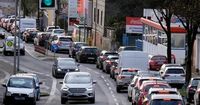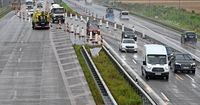On the weekend of September 13 and 14, 2025, drivers across Germany faced a familiar and frustrating foe: traffic congestion. From the northern coast in Rostock to the bustling industrial corridors of North Rhine-Westphalia, and from the rural stretches of Havelland to the historic streets of Celle, a patchwork of construction sites, accidents, and sheer volume brought many highways and city arteries to a crawl. But what’s really going on behind the wheel—and how are modern systems helping motorists steer clear of the worst jams?
According to reports from Celler Zeitung, Märkische Allgemeine Zeitung, Ostsee-Zeitung, Remscheider General-Anzeiger, and Solinger Tageblatt, September’s second weekend was marked by a mix of scheduled roadworks, accident-related delays, and some of the country’s most notorious bottlenecks living up to their reputations. The backbone of these up-to-the-minute traffic warnings? TomTom, a navigation giant whose data—sourced from millions of GPS-equipped devices, mobile phones, and street sensors—provides a real-time tapestry of Germany’s roadways, refreshing every five minutes.
Let’s take a closer look at the regions hit hardest by congestion and how the technology behind the traffic alerts is shaping the daily lives of commuters and travelers alike.
Celle: Construction and Caution
In Celle and its surrounding areas, drivers experienced significant slowdowns on September 14, 2025, as reported by Celler Zeitung. The main trouble spots? Bundesstraße 3 (B3) heading towards Hannover and Soltau, Bundesstraße 214 (B214) towards Braunschweig and Schwarmstedt, Bundesstraße 191 (B191) in the direction of Uelzen, and Wilhelm-Heinichen-Ring within Celle itself, where ongoing construction forced many to take lengthy detours. The newspaper emphasized the importance of patience and courtesy, urging, “Please take other road users into consideration!”
What’s fueling these updates? TomTom’s data, collected from an astonishing 80 million mobile devices, millions of official road sensors, and manual reports, ensures that the public receives accurate, current information. The system’s five-minute refresh rate means that drivers can adjust their routes almost in real time—assuming, of course, they’re checking before getting stuck in gridlock.
Havelland: Delays Across the Heartland
Just a day earlier, on September 13, 2025, the Märkische Allgemeine Zeitung highlighted congestion across Havelland, especially in towns like Falkensee, Nauen, and Rathenow. The main arteries affected included the A2, A10, and A14 autobahns, along with Bundesstraßen B5, B102, and B188. As in Celle, the TomTom-powered traffic warning system kept locals and long-haul drivers alike informed of new bottlenecks and accident-related delays. The message was clear: “Always be considerate of other road users.”
With these regions relying on a combination of cutting-edge technology and community updates, it’s clear that real-time traffic management has become an integral part of daily life, especially in areas where alternative routes are limited and construction is a constant companion.
Rostock: Major Renovations and Long-Term Plans
In the northeast, Ostsee-Zeitung reported on September 14, 2025, that Rostock and its neighboring towns—Bad Doberan, Sanitz, and Güstrow—were grappling with delays on the A19 and A20 autobahns, as well as the B103, B105, and B110. But the real story in Rostock is the scale and duration of the city’s infrastructure projects. Starting in February 2025, the Neubrandenburger Straße is undergoing a three-part renovation, with the southern segment’s construction expected to last around nine months, weather permitting. This is no minor inconvenience: city officials warn of “massive restrictions” for drivers throughout the year.
And that’s only the beginning. City works to bring district heating to residential areas along Neubrandenburger Straße will trigger long-term closures, while the bridge on Rennbahnallee near the zoo is slated for demolition and complete rebuilding—though that won’t begin until autumn 2026. The Vorpommernbrücke, another vital link, is set for replacement in 15 to 20 years, a testament to the city’s forward planning (and perhaps the patience required of its motorists).
Again, TomTom’s data underpins these updates, offering a lifeline to those hoping to avoid the worst of the chaos. As Ostsee-Zeitung puts it, the data is “updated every five minutes using GPS data from millions of devices.”
Remscheid and Solingen: NRW’s Congestion Hotspots
In North Rhine-Westphalia, the industrial heartland of Germany, traffic woes are nothing new. On September 13, 2025, Remscheider General-Anzeiger painted a picture of near-constant congestion in Remscheid, Wermelskirchen, Solingen, and Wuppertal. The main offenders? Autobahns A1 and A46, Bundesstraßen B51, B51n, B229, B237, B483, and Landesstraßen L74, L81, L101, and L418.
The statistics are eye-opening: in 2023, the A1 stretch between Cologne and Dortmund racked up nearly 6,500 hours of traffic jams, making it one of the country’s leading bottlenecks. The A46 between Düsseldorf and Wuppertal wasn’t much better, holding the dubious honor of being the sixth most congested highway in NRW. And with the massive reconstruction of the Wuppertal-Nord interchange underway—a project expected to last a decade—the headaches are unlikely to ease anytime soon.
Solingen’s woes, reported by Solinger Tageblatt on September 14, 2025, mirror those of its neighbor. The A3, which runs from Cologne to Oberhausen and passes near Solingen, was the most congested highway in NRW in 2023, with over 10,000 hours of jams. Ongoing construction, closures, and detours at the A3 Solingen junction have only made matters worse. The B229 and B224, along with vital local roads like the L74 and L357, are essential for commuters trying to navigate the region’s dense web of highways and city streets.
Both newspapers stress the same point: TomTom’s data, refreshed every five minutes, is a crucial tool for keeping drivers informed and—hopefully—out of the worst jams.
The Bigger Picture: Technology, Patience, and the Road Ahead
Across all these regions, a few themes emerge. First, the scale and complexity of Germany’s road network—and the sheer volume of traffic—make congestion an almost daily reality. Second, the increasing reliance on real-time data from navigation systems like TomTom (as well as competitors such as Google Maps, Apple Karten, and Garmin) is changing the way drivers plan their journeys. With updates every five minutes, there’s at least a fighting chance of avoiding the worst delays—if not the frustration that comes with them.
Finally, the newspapers’ repeated calls for patience and consideration on the roads are a reminder that, no matter how advanced the technology, a little human kindness still goes a long way. As cities and regions invest in long-term infrastructure improvements, drivers will need to balance technology’s promise with the realities of construction, detours, and the occasional gridlock. For now, the best advice remains: check your route, stay alert, and try not to let the traffic get the better of you.

